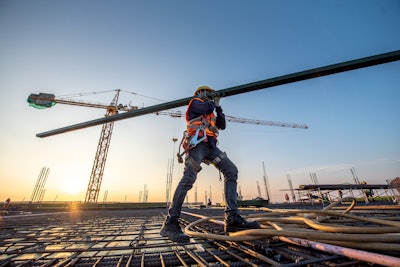
Being prepared by having the right type of pants ensures a construction worker is best protected for whatever a job requires in various weather conditions.
Learn about the different kinds of pants used on construction sites today.
Cargo Work Pants
Cargo work pants are extremely functional for construction work, featuring more pockets and storage space as well as belt loops.
Common fabrics include polyester, cotton twill, canvas, ripstop and denim – the choice dictated by the type of work being done and the varying degrees of toughness and durability required. In hot weather environments, cotton may be preferred.
Asphalt workers encounter extreme heat, abrasive materials and sharp tools, calling for heavy-duty leg protection in the form of asphalt pants. The National Fire Protection Association (NFPA) 2112 Standard provides minimum requirements for flame-resistant garments. Ratings are provided by the NFPA and the American Society for Testing and Materials. Arc Flash ratings are important.
Flame resistant garments certified by Underwriters Laboratories meet the requirements of NFPA 2112 Standard on Flame Resistant Garments for Personnel Against Flash Fire, 2007 Edition.
Other key factors are breathable fabric, moisture management and water-resistant features protecting moist liquids from permeating the pants and reaching the skin. Denim or canvas pants help with abrasion resistance.
The functional design of cargo pants offers storage space for items needed when working on asphalt, helpful for those preferring not to wear a tool belt. Pants with reinforced knees or openings for knee pads provide extra knee protection.
Pants for asphalt work feature a relaxed fit in the seat and thighs and reinforced crotches.
Pockets should have closures to ensure items will not fall out into hot asphalt. Non-conductive plastic buttons are designed for electrical safety and to prevent scratching equipment.
High-visibility pants help workers stand out in high traffic and low-light conditions. ANSI Class E apparel is a supplemental classification of an apparel type designed to increase visibility. EN ISO 20471 Class 2 offers an intermediate level of visibility.
Tasks involving frequent stooping, kneeling, or squatting puts knees at risk for injury.
Double Knee Pants
As noted in this IRONPROS article, double knee work pants feature two layers of fabric starting below the knee and running up toward the thigh for knee cushioning.
Double-knee pants often are designed as a utility pant with multiple storage pockets in the front and back as well as tool loops. Common fabrics include canvas, denim, cotton duck and rip-stop or polyester and cotton blends. Insulated fabric may be preferred in winter, while a lighter fabric may be desired in warm weather.
Some construction work pants are designed with pockets at the knee to accommodate removable knee pads. Others are designed with the pad sewn in or attached at the knee.
Bib overalls can provide chest-to-toe protection against heat, thermal and electrical effects and chemical and hazardous materials. They provide plenty of storage capacity. They may be designed with reinforced knees and adjustable straps. Coveralls cover all of the body, minimizing skin exposure.
As for breathable work pants, the material needs to withstand wear and tear and provide the ability to move without impediment. While breathable work pants are desirable in hot weather, they also can be worn in cold weather, possibly with thermal underwear layered underneath.
Wind and water resistance are other desired factors.
Work Pants for Women
Women comprise 11 percent of the construction workforce. The U.S. Department of Labor in July 2023 announced a proposed rulemaking clarifying the construction industry personal protective equipment (PPE) standard as the current standard doesn’t clearly state PPE must fit each affected employee properly.
OSHA notes women’s PPE – including pants – should be based upon female anthropometric (body measurement) data. The best pants for women may feature a contoured waistband to prevent gapping in the back. A higher rise in the back accommodates a curvier lower back. Women’s construction work pants often feature curvature in the hip and thigh.
Women’s construction pants may have a shorter inseam length to cater to generally shorter average height compared to men and feature a crotch gusset. Brands offering maternity work pants typically offer a wide range of sizes and stretch materials to cater to the various stages of pregnancy.
Safety is a priority when choosing construction work pants. Check with a safety manager to ensure clothing being worn at the jobsite meets all safety requirements.
















